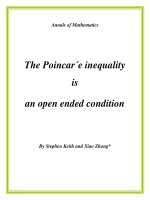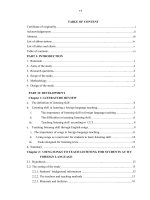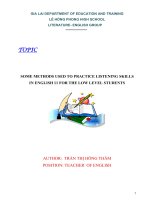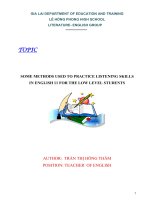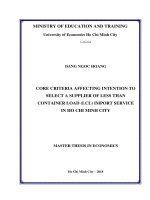Important criteria to select listening text input
Bạn đang xem bản rút gọn của tài liệu. Xem và tải ngay bản đầy đủ của tài liệu tại đây (48.15 KB, 5 trang )
Part 1. Module 3
1. What are important criteria to select listening text input?
ANSWER
The acoustic input
The external input into the listening comprehension process is an acoustic signal. This
represents the meaningful sounds of the language, the phonemes. These phonemes
combine together to make up individual words, phrases, etc.
Phonological modification
The process by which sounds are modified is regular and rule governed. It depends on a
set of phonological rules which vary from one language to another. In normal-speed
speech, some sounds are modified by the sounds next to them; some are simply dropped,
others are combined in complex ways.
Stress and intonation
The English stress pattern gives each word an individual form, which is as much a part of
the sound of the word as the actual phonemes. Furthermore, speakers stress what they
think is important, and the most important words, those that express the core meaning,
get additional stress. Intonation patterns are closely related to the structure and meaning
of the text.
Redundancy and shared knowledge
Language is by its nature extremely redundant. Speakers know this and instinctively
modify their speech depending on the situation, and their knowledge of the listener. Thus,
words with a high information content that is non-redundant word, to be more clearly
articulated than redundant words which have a low information content.
The real-time nature of spoken language
The necessity of automatic processing
Given the speed and complexity of normal speech, the more automatic the listener’s
processing, the more efficient it will be, and the faster it can be don; and conversely, the
less automatic the processing, the more time will be required.
Interpretations vary
There are many reasons explaining why the listening process may go wrong. This could
be due to background noise, or listeners may have their attention distracted, or be
thinking of something else, the effects of background knowledge…
Linguistic features of spoken texts
Language of speech should be different from language of writing.
Planned and unplanned discourse
Most spoken texts are just a rough first draft. This is usually referred to as unplanned
discourse, which is spontaneous and produced without taking much time for planning and
organization. On the other hand, planned discourse is considered to be polished and
worked text. Moreover, the grammar of unplanned discourse tends to be different from
planned discourse. Normally in planned discourse the relationship between the ideas and
propositions is expressed by means of the syntax. However, in unplanned discourse the
context itself can be used to connect the propositions. Similarly, referents are often
missing, and listener may have to infer who, or what, the speaker is talking about.
Linguistic differences between speech and writing
In spoken language idea units tend to be shorter, with simpler syntax, which tend to be
strung together by coordinating conjunctions. Spoken language usually has hesitations:
pauses, fillers, and repetition that give the speaker more thinking time, as well as repairs,
such as false starts, corrections in grammar or vocabulary, and afterthoughts. Spoken
language tends to have more non-standard features such as dialect, slang, and
colloquialisms and tends to be far more personal, with more emotional involvement and
much less precision.
The listening situation
The degree of interaction between the listener and speaker
The listener’s role may be non-collaborative, requiring nothing more than interpreting the
speaker’s utterance or collaborative listening, making appropriate requests for
clarification, back-channelling, making responses to interactional language, or taking
responsibility for organizing turn-taking.
The listener’s responsibility to respond
In many situations, the listener also has responsibilities to respond in predetermined ways
such as “thank you” or “ you’re welcome”, and there are lots of other situations where
some reasonably fixed response is expected: greetings, inquiries about health,
compliments…
Another responsibility is to provide back-channelling, that is to give signs to the speaker
that we are understanding what is being said, and that we are paying attention. This takes
the form of formulaic expressions such as “really”, “yeah”, “oh yes”, “I see”, “how
interesting”….
2. Name the three listening subskills and give an example for each one?
ANSWER
The two-stage view
At the first stage, the basic linguistic information is extracted, and then a second stage in
which that information is utilized for communicative purpose.
In other words, the first stage is the “recognition level”, involves the identification of
words and phrases in their structural inter-relationship, the second one is “selection”,
where the listener is drawing out from the communication those elements which seem to
contain the gist of message.
Probably the clearest example is Carroll (1972), who describes listening comprehension
as a two-stage process: first the apprehension of the linguistic information contained in
the message, and second the application of that linguistic information to the wider
communicative context.
A cognitive skills approach
Valette (1977:20) demonstrates a series of increasingly complex cognitive skills:
Mechanical skills: the listener performs by rote memory, rather than by understanding.
For example, perceiving differences between two or more sounds and making distinctions
between them.
Knowledge of the language: the listener demonstrates this by showing knowledge of
facts, rules, etc. This can be done by answering simple questions about the language.
Transfer: the listener uses this knowledge in new situations, for example taking
information from one source and using it for a new purpose.
Communication: the listener uses the language as a natural vehicle for communication,
for example when a message containing new information is understood.
Criticism: the student analyses or evaluates a piece of language in terms of its
effectiveness, appropriacy, style, tone…
Communicative approach
Aitken (1978) described listening skills in communicative terms, taking into account a
variety of skills which are concerned with relating the basic linguistic processing to the
wider communicative situation. He concluded there are some skills needed to process and
comprehend speech:
Understanding the vocabulary and being able to guess the meanings of unfamiliar or
unclear words from their context.
Understanding the syntactic patterns, the morphological forms characteristics of spoken
language, and following the discourse patterns of spoken language.
Understanding the flow of stressed and unstressed sounds, as well as intonation cues and
other cues of oral punctuation.
Identifying the speaker’s purpose.
Drawing correct conclusions and valid inferences about the social situation, the speaker’s
intent or the general context.
Recognizing the speaker’s attitude to the listener and the subject of their discussion.
Identifying the techniques and rhetorical devices the speaker used to convey the
message.


